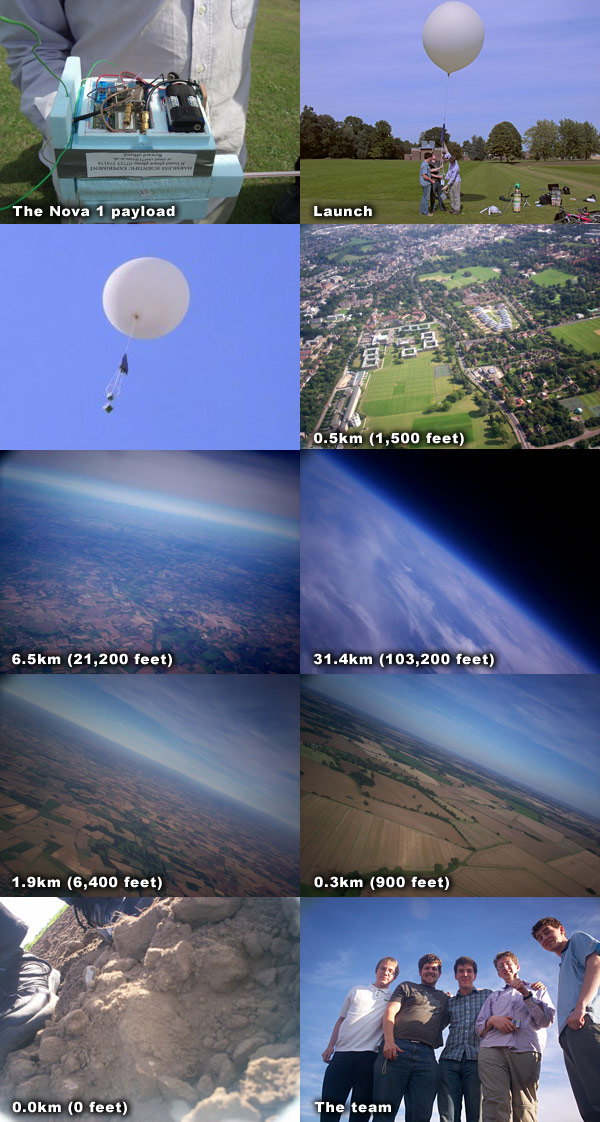Original URL: https://www.theregister.com/2006/09/18/nova_1/
UK uni rocket payload test hits 105,600ft
Balloon flight success for budget von Brauns
Posted in Science, 18th September 2006 11:14 GMT
Students from the University of Cambridge "Spaceflight" project last week pulled off quite a coup when they successfully dispatched an experimental electronics package into the upper atmosphere strapped to a weather balloon, in the process capturing some impressive images of planet Earth from a peak altitude of 32.2km (105,600ft)
The main objectives of the "Nova 1" test were "to gain experience operating balloon payloads, to test the hardware and firmware of the latest generation tracking device flight", as part of a programme aiming to ultimately build a sub-£1,000 rocket.
The payload contained "two completely independent custom-built tracking devices with three communications methods: SMS over a GSM cellphone, high speed radio data and low speed radio Morse code. Both radio transmitters operated at 10mW in the 434MHz licence-exempt band", the team's report explains.
To record the test for posterity, the package also boasted a 5 megapixel digital camera, which performed splendidly, as this sequential montage shows:
(Team comprises: Carl Morland, Robert Fryers and Henry Hallam in the centre from L-R, flanked by two friends)
The balloon was launched last Saturday from Churchill College, Cambridge. It contained enough helium to lift the payload and deliver 600g of excess lift. It rose at around five metres per second until reaching its peak altitude two hours after release. At this point, the balloon burst and the payload fell at a maximum velocity of 45m/s (100mph) before thicker atmosphere coupled to deployment of a 45cm parachute slowed it to a terminal velocity of 5.5m/s (12mph). Two hours and 46 minutes after taking to the skies, Nova 1 touched down a field near Great Livermore, north of Bury St Edmunds in Suffolk.
The team had been tracking the flight while giving chase in a car. Despite the loss of the data radio signal, "believed to be due to low temperature affecting the frequency of the crystal oscillator" and the failure of the antenna connection on the morse code receiver, the proto-von Brauns were able to eventually recover the payload after a post-touchdown text message from the onboard mobile phone revealed its precise location.
Project founder Carl Morland said: "This marks the first step in a series of flights to prove our tracking and telemetry systems. Once we can take a larger payload stably up to 30km, we will be in a position to launch a rocket from the balloon that will reach the 100 kilometre boundary of space for a tiny fraction of the present cost."
Next up for the Spaceflight team is analysis of the flight data and more work on lightening the payload. Carl Morland told El Reg that future launches would carry school science projects in the hope that direct involvement in the project would "catch them while they're young", as he put it. Infant schools would be invited to put together something the size of, for example, a film cannister, while secondary schools might want to try something on a larger scale*.
As for the budget rocket, Moreland said they hoped to go for a test launch is summer 2007. Reassuringly, he told us it would never be used in anger against Oxford University. ®
Related links
- The team's launch report.
- Selected snaps from the Nova 1 flight.
- All 857 images from "NovaCamera".
- Nova 1 data log files.
Bootnote
*While we were on the phone, Carl rather agreeably offered The Register some payload space on a future flight. Accordingly, we've decided to throw this one over to you, our beloved readers. More details here.
